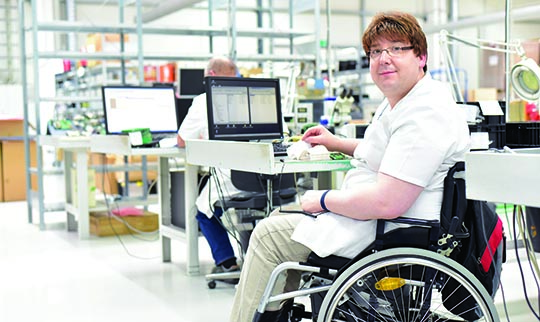Spinal Cord Injury Ontario helping to create inclusive workplaces
January 14, 2019
Spinal Cord Injury Ontario (SCIO) provides a dedicated client service group offering a number of important services to support individuals living with an injury as well as a network of business partners. Several retailers such as Apple, Ikea, Walmart and Home Depot, are among the employers that turn to SCIO to reach their inclusion goals.
BY SEAN C. TARRY
INTEREST in SCIO’s services has increased in recent years, says Lubna Aslam, SCIO employment counselor. “A lot of retailers are approaching us not just from a social responsibility standpoint, but also with the understanding that having someone on staff with a disability can promote customer loyalty and help co-workers. ”
SCIO’s role is twofold. The first order of the day is preparing potential candidates for employment readiness. The other is working with its business partners to ensure a seamless transition for employees with disabilities entering their workplace.
All walks of life
Aslam stresses that SCIO deals with a broad base of candidates. “We see people of all ages and levels of education coming in to see us, a large number of which have graduate degrees. It may be an individual who is newly injured and needs to change their role within their current job. Others have been let go because of downsizing and looking to re-enter the workforce. Still, others are first-time job seekers.”
For new candidates, the group offers workshops focused on job readiness. Sessions revolve around developing hard and soft skills, as well building expertise around legal issues and disclosure. “Candidates need to learn about what questions can be asked and how to tackle any inappropriate questions on the part of an employer,” she explains.
There is also an assistive technology unit, where individuals can familiarize themselves with innovations that can support them in the workplace, such as speech to text software.
Each person also works with an assigned employee counsellor to develop realistic goals. The counselling needed can differ considerably depending on the person’s work experience and disability, Aslam says. “The key is to determine realistic and achievable goals and the transferable skills needed to prepare them for entry in the workforce. For example, they may need training on POS systems or customer service.”
Once they have established relevant training, job seekers are paired with an employment specialist who works with SCIO’s employer partners to determine an appropriate fit.
Employer needs
As for employers, each is assigned a sector-specific account manager who works with them to assess and understand their current business requirements. “This needs analysis provides employers with a good understanding of their hiring needs and the culture,” Aslam says. “That plays a big part in how successful a business can ultimately be in hiring and retraining people with disabilities.”
“DISABILITY AWARENESS IS NOT ABOUT EVERYONE HAVING TO WALK ON EGGSHELLS. THAT’S NOT WHAT SUCCESSFUL INTEGRATION LOOKS LIKE. RATHER WE ARE TRYING TO BRING TOGETHER A SOCIETY THAT DOESN’T CREATE DISTANCES BETWEEN PEOPLE WITH DISABILITIES AND THOSE WITHOUT.”
LUBNA ASLAM
SCIO
SCIO handles the pre-screening of candidates. In the event that they don’t have an ideal candidate for the role, it works with agencies such as the Discover Ability Network, Canadian Business SenseAbility, Job Opportunity Information Network (JOIN), and The Ontario Disability Employment Network. “Having this network increases the chances of finding the ideal candidate for a role,” Aslam says.
Aslam stresses that SCIO’s role does not end once a person is hired. “We also help the individual and employer through the recruitment process to determine what accommodations may be required in terms of the workplace environment, wellness training, and assistive technology.”
Coaching and assessment
Once a person is hired, SCIO will also provide job coaching “behind the scenes” to bridge the gap between the job seeker and the employer to ensure reporting and communications are seamless.
SCIO will also conduct worksite assessments to determine whether or not the employer’s place of business is accessible enough and to eliminate any potential physical or other barriers. In addition, team members will conduct consultations with HR on best practices and, where needed, disability awareness and/or sensitivity training.
“Disability awareness is not about everyone having to walk on eggshells,” Aslam says. “That’s not what successful integration looks like. Rather we are trying to bring together a society that doesn’t create distances between people with disabilities and those without.”
All services, with the exception of the disability awareness programs, are provided free of charge.
Aslam notes that hiring people with disabilities offers proven benefits. “Some employers’ most common concerns are absenteeism and accommodation costs around mobility, technology adoption and visibility. But according to The Ontario Disability Employment Network, people with disabilities are less likely to be absent, showing 85 per cent above average to average attendance records.”
The Job Accommodation Network also reports that every dollar spent on accommodation yields an average return of $1.26, she adds. “These numbers dispel some of the myths around hiring persons with disabilities.”
Hiring people with disabilities is also good from a consumer spending standpoint, she adds. Canadian Business SenseAbility estimates that the buying power of Canadians with disabilities is $55.4 billion—a number that increases to $336.5 billion when taking into account family members and friends.
“As a person who uses a wheelchair myself, when I pass a place that doesn’t allow me to go in, I feel my business is not welcome,” Aslam says. “If you can create a positive experience for a customer, we are more likely to shop there and will recommend you to everyone we know.”



